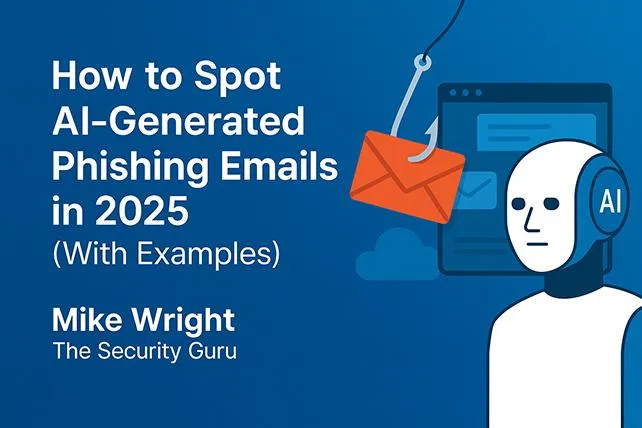
How to Spot AI‑Generated Phishing Emails in 2025 (With Examples)
How to Spot AI‑Generated Phishing Emails in 2025 (With Examples)
AI phishing is no longer science fiction—it’s hitting inboxes daily.
In 2025, attackers are using tools like WormGPT, FraudGPT, and open-source language models to create phishing emails that sound human, look legitimate, and trick even trained professionals.
In this post, you’ll learn how to spot AI-generated phishing emails, see real examples, and protect your team before they click something they regret.
Why AI-Phishing Is Exploding in 2025
AI-written phishing emails aren’t full of broken English and typos anymore. They’re smart. They’re fast. And they’re scarily convincing.
In 2025, tools like WormGPT and deepfake email engines can now:
Mimic tone and style of known senders
Personalize content to your role or industry
Bypass basic filters and automated defenses
One financial advisor lost $1.3M when a client wire transfer request turned out to be AI-generated. The email passed every manual check—except the human gut check.
What Makes AI Phishing So Dangerous
Here’s how AI makes phishing more effective than ever:
• Natural-sounding grammar — The emails read like a native speaker wrote them.
• Hyper-personalization — The AI mimics your tone, job role, industry language.
• Email spoofing combined with AI — The “From” address and message tone feel completely authentic.
• Speed and scale — Attackers can launch thousands of personalized phishes in minutes.
10 Red Flags to Detect AI‑Generated Phishing Emails
Use this checklist to spot and stop AI-driven phishing attempts:
🚩 1. Tone mismatch
Does the email sound slightly off—too formal or too casual for the sender?
🚩 2. Vague urgency
Phrases like “Need this processed quickly” without context or clarity are common AI patterns.
🚩 3. No follow-up path
No phone number, reply thread, or calendar invite—AI can’t simulate full business context well.
🚩 4. Unusual attachment names
Look out for odd file names like invoice_urgent_45b.pdf or transfer_auth_final.docx.
🚩 5. Subtle hallucinations
An AI might refer to a meeting that never happened or assign someone the wrong job title.
🚩 6. Odd time-of-day patterns
Was it sent at 3:17 a.m.? That’s a sign of automation.
🚩 7. Overuse of synonyms
Instead of “Please review,” you might see “Kindly assess and evaluate at your earliest.”
🚩 8. Signature inconsistencies
If Mike usually signs emails as “-Mike,” but this one says “Michael Wright, MSc, CISSP,” something’s off.
🚩 9. Unusual language density
AI emails often feel overly formal or verbose without emotion or shortcuts.
🚩 10. Too-perfect grammar
No typos, no contractions, overly polished—humans rarely write like that.
What to Do If You Suspect an AI Phish
• Don’t click anything. Forward it to your security team or IT helpdesk.
• Verify out-of-band. Call or text the person who “sent” the email using a number you already know.
• Check email headers. Tools like Gmail’s “Show original” can expose spoofed sources.
• Use real-world training. Simulate phishes to prepare your team with examples like the one below.
Real-World Example
Subject: Urgent: Final Review Needed for Funds Transfer
“Hi Chris, please confirm you’ve reviewed the documents I uploaded yesterday. We must complete the transfer by COB today—client’s deadline. Let me know once processed.”
Why this is suspicious:
You’re not Chris
There was no email sent “yesterday”
The domain is slightly spoofed
Urgency with no context and an attachment = 🚩
Final Takeaway from Mike
The future of phishing isn’t broken English. It’s perfect English.
And that’s what makes it dangerous.
Want to Test Your Team’s Phishing Defenses?
Let’s run a quick audit.
📩 Contact Mike here
